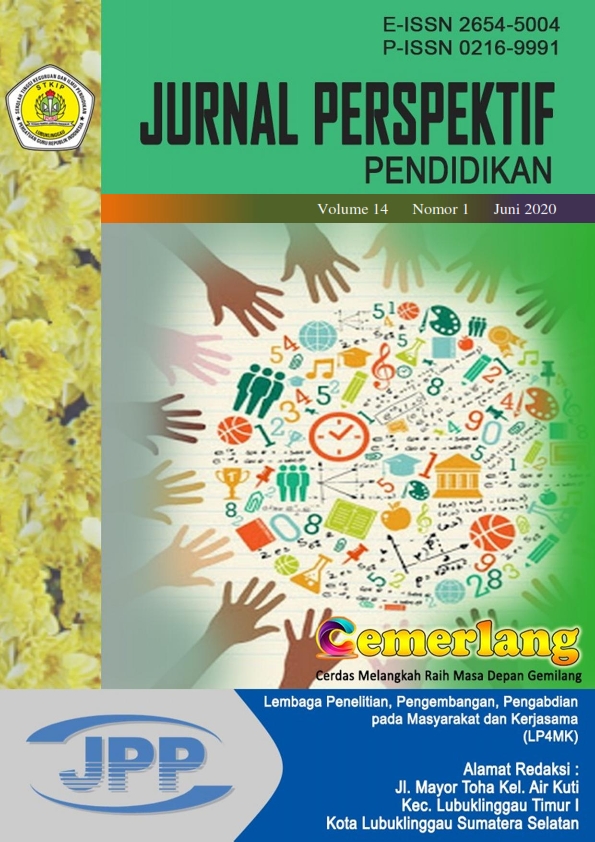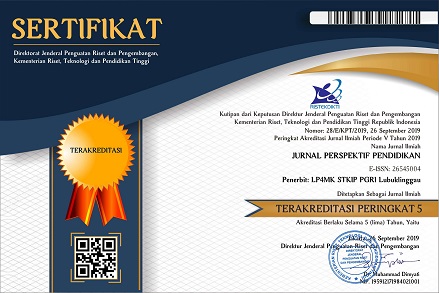TEACHING READING COMPREHENSION FOR THE TENTH GRADE STUDENTS BY APPLYING THE INQUIRY BASED LEARNING APPROACH
Abstract
The objective of this research was to find out whether or not it was significantly effective to apply the Inquiry Based Learning Approach in teaching reading comprehension for the tenth grade students. In this research, the researcher proposed two hypotheses. They were null hypothesis (Ho) and alternative hypothesis (Ha). The method applied was pre-experimental with one group pre-test posttest design. The object of this research consisted of 20 students. The data were collected by means of test consisting 20 items of multiple choices. The data obtained were analyzed through three techniques: 1) Individual Score, 2) Conversion of Individual Score Based on Minimum Mastery Criteria, and 3) Matched t-test. The results of this research shows that the students’ mean score in the pre-test was 60.13 and those in the post-test was 75.25. The result of matched t-test was 5.25, which was higher than t-table value (1.725) of 20 with 95% significant level for one tailed-test. Therefore, the null hypothesis (Ho) was rejected and the alternative hypothesis (Ha) was accepted. It means that it was significantly effective in teaching reading to the tenth grade students by applying Based Learning Approach.
References
Amri, S. & Ahmadi, KS. (2010). Proses Pembelajaran Kreatif dan Inovatif Dalam Kelas.Jakarta: PT. Prestasi Pustaka Raya.
Banchi, H. & Bell, R.( 2008). Teaching Reading by Using Inquiry Based Learning Approach. [Online]. http//www.google.warming-upforreadingpdf.com. Accessed on August 24, 2016.
Catherine, S. C. (2002). Reading for Understanding.Pittsburgh ; Rand Reading Study Group.
Cooper, L. & Prescot, T. (1989).The Reading Priority in English. New York; NY: McGraw-Hill, Inc
Dewey, Jhon. (2012). Inquiry Based Learning Approaches to Learning. [Online]. http://www.glencoe.com/sec/teachingtoday/subject/inquirybased.phtml. Accesed on August 27, 2016.
Fraenkel, J.R.& N. E. Wallen.(1993). How to Design and Evaluate Research in Education. New York, NY: McGraw-Hill, Inc.
Gunning, G. T. (1992).Reading Comprehension Boosters. United State Of America ; John Wiley & Sonic, Inc. All rights reserved.
Ruddell, R. M. (2005). Teaching Content Reading and Writing. Danvers, MA: John Wiley & sons, Inc.
Sahara. (2012). The Application of PBI (Problem Based Intruction) Technique in Teaching Speaking to the Eight Grade Students at MA Negeri 1 (Model) LubukLinggau. Unpublished Undergraduate Thesis. LubukLinggau: Language and Arts Education STKIP-PGRI LubukLinggau.
Saleh, Y. (1997). Approaches of Teaching English as A Foreign Language in the Indonesian Context Book 1. Palembang: Faculty of Teacher Training and Education, Sriwijaya University.
Saleh, Y. (1997). Methodology of TEFL in Indonesian Context.Faculty of Teacher Training and Education Sriwijaya University, Palembang.
Sanjaya. W. (2006). Strategi Pembelajaran Berorientasi Standar Proses Pendidikan. Jakarta: Kencana Prenada Media.
Saraka. (1988). From Paragraph to Essay, Concepts and Practice. Departemen Pendidikan dan Kebudayaan, Direktorat Jenderal Pendidikan Tinggi, P2LPTK. Jakarta.
Siahaan, S.(2008). Issues in Linguistics. Yogyakarta: Graha Ilmu
Trumble, J (2001). The Great Dictionary of English: London: Longman, Ltd.
Tomlinson, B. (1998). Materials Development in Language Teaching. New York: University Press, Cambridge.
Wilherm. (2010). Criteria For a Successful Inquiry. Online http://Amazone Components2.html, Accesed on August 12, 2016.

This work is licensed under a Creative Commons Attribution-NonCommercial-ShareAlike 4.0 International License.

Jurnal Perspektif Pendidikan by https://www.ojs.stkippgri-lubuklinggau.ac.id/index.php/JPP is licensed under a Creative Commons Attribution-NonCommercial-ShareAlike 4.0 International License.















